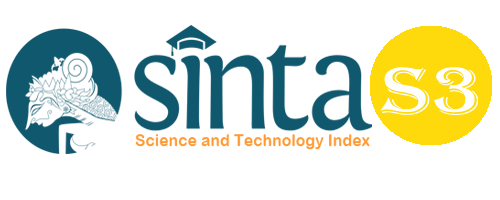Evaluation of Tax Service Application User Satisfaction for Sustainable Service Digitization
Abstract
E-TPT is an android-based application that is used in carrying out public services, especially in the field of taxation. The main service of this application is the online queue menu, but in its implementation the use of this application is still experiencing some problems so that follow-up is needed in overcoming the problem. The purpose of this study was to determine and explain the effect of perceived ease and usefulness on user satisfaction and behavioral interest in using the E-TPT Application. Therefore, research is carried out using quantitative methods and involves a number of theories to evaluate the use of applications, the theoretical models used include Theory Acceptance Model (TAM), Theory Reaction Action (TRA), accompanied by model development which includesPerceived usefulness, Perceived ease of use,Behavioral Intention to Use, and User Satisfaction. Perceived usefulness has a significant effect on user satisfaction, perceived usefulness has a significant but not significant effect on behavioral interest in using applications, and perceived usefulness has a significant effect on behavioral interest in using applications through user satisfaction. Furthermore, perceived ease of use has an insignificant but not significant effect on user satisfaction, perceived ease of use has a significant effect on behavioral interest in using applications, and perceived ease of use has an insignificant effect on behavioral interest in using applications through user satisfaction. User satisfaction has a significant effect on behavioral interest in using the application. Increasing user satisfaction and interest in using this application can be done by developing applications. In the application development process, you can consider the speed of the application in completing work, improve user performance and user convenience in application control as well as conduct research and planning related to the needs of taxpayers on the application.
Keywords
Full Text:
PDFReferences
Adamson dan Shine. (2003). Extending the New Technology Acceptance Model to Measure the End User Information System in a Mandatory Environment. Journal A Bank’s Treasure Technology Analysis and Strategic Management, Vol. 15 No.4.
Ahmad dan Pambudi, B.S. (2014). Pengaruh Persepsi Manfaat, Persepsi Kemudahan, Keamanan Dan Ketersediaan Fitur Terhadap Minat Ulang Nasabah Bank Dalam Menggunakan Internet Banking. Jurnal Studi Manajemen, Vol.8 No.1 April 2014.
Achmad Kuncoro, Engkos. Dan Riduwan. (2007). Cara Menggunakan dan Memaknai Analisis Jalur. Bandung : Alfabeta. Ardianto, Elvinaro
Andrian, Agus. (2014). Analisis Pengaruh Persepsi Kegunaan, Persepsi Kemudahan Penggunaan, Dan Sikap Penggunaan Terhadap Minat Perilaku Penggunaan Billing System. Skripsi Jurusan Administrasi Bisnis Universitas Brawijaya.
Davis, Fred D. (1989). Perceived Usefulness, Perceived Ease of Use, and User Acceptance of Information Technology. Journal MIS Quarterly, Vol.13, No.3 dalam http://www.jstor.org (diakses tanggal 24 November 2016).
Darmawan, Deni. (2014). Metode penelitian kuantitatif. Bandung: PT Remaja Rosdakarya.
DeLone W. H. and McLean E. R. (2003) The DeLone and McLean model of information systems success: a ten-year update. Journal of Management Information Systems 19(4), 9–30.
Fadillah, A. et al. (2021). Analysis of Information Quality, Trust and Satisfaction on Customer Participation (Case Study on Customer Online Shop Shopee in Rantauprapat). Budapest International Research and Critics Institute-Journal (BIRCI-Journal). P. 3039-3051.
Fisbein, M. dan Ajzen, I. (1979). Belief, Attitude, Intention, and Behavior: An Introducion to Theory and Research. Addison-Wesley. Reading, MA.
Igbaria, MN, Zinaelli and Cavaye. (2000). Personal Computing Acceptance Factors in Small Firm: a Structural Equation Model. Journal MIS Quartely.
Jogiyanto, Hm. (2007). Sistem Informasi Keperilakuan. Yogyakarta: Andi.
Jogiyanto, Hartono. 2008. Metodologi Penelitian Sistem Informasi. Penerbit Andi. Yogyakarta,
Kementerian Keuangan RI. (2014). www.kemenkeu.go.id diakses pada 6 April 2019.
Laihad, Risal C.Y. (2013). Pengaruh Perilaku Wajib Pajak Terhadap Penggunaan E-Filling Wajib Pajak di Kota Manado. Jurnal EMBA, Vol. 1 No. 3 September 2013 Hlm. 44-51.
Laksono, Hari. (2017). Evaluasi Kesuksesan SIMDA BMD pada Pemerintah Kabupaten Grobogan Menggunakan Model Kombinasi Delone McLean dan Technology Acceptance Model. Jurnal Tata Kelola dan Akuntabilitas Keuangan Negara.
Muliati, Niswah. (2010). Pengaruh Perceived Usefulness, Perceived Ease of Use, Attitude Toward Using, dan Behavior Intention to Use, terhadap Actual System Use dalam Implementasi Teknologi Enterprise Resource Planning (ERP) System (Survei pada End-User ERP System di PT Semen Gresik). Tesis. Program Magister Ilmu Administrasi Bisnis, Fakultas Ilmu Administrasi. Universitas Brawijaya. Malang.
Nelson, R.R., Todd, P.A. and Wixon, B.H. (2005), “Antecedents of information and system quality: an empirical examination within the context of data warehousing”, Journal of Management Information Systems, Vol. 21, pp. 199-235.
Rahayu, Siti Kurnia. (2010). Perpajakan Indonesia Konsep dan Aspek Formal. Yogyakarta: Graha Ilmu.
Sudjana. (2005). Metoda Statistika, Edisi 6, Bandung: Tarsito
Sugiyono. (2012). Metode penelitian (pendekatan kuantitatif, kualitatif, dan R&D). Bandung: Alfabet.
Sugiyono. (2013). Statistika untuk Penelitian, Bandung: Alfabeta
Venkatesh, V. Morris, M.G., Davis G.B., dan Davis, F.G. (2003). User Acceptance of Information Technology: Toward a Unified View. MIS Quarterly, 27 (3): 425 – 278
Zaied, Abdel N. H. (2012). An Integrated Success Model for Evaluating Information System in Public Sectors. Journal of Emerging Trends in Computing and Information Sciences. Vol. 3 No. 6, July 2012.
DOI: https://doi.org/10.33258/birci.v4i4.2745
Article Metrics
Abstract view : 72 timesPDF - 45 times
Refbacks
- There are currently no refbacks.

This work is licensed under a Creative Commons Attribution-ShareAlike 4.0 International License.

This work is licensed under a Creative Commons Attribution-ShareAlike 4.0 International License.

_.gif)

















_.gif)



